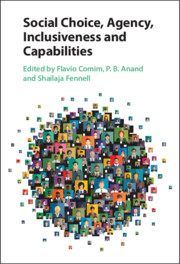Book contents
- Social Choice, Agency, Inclusiveness and Capabilities
- Social Choice, Agency, Inclusiveness and Capabilities
- Copyright page
- Contents
- Figures
- Tables
- Contributors
- Preface and Acknowledgements
- 1 Introduction: social choice, agency, inclusiveness and capabilities
- Part I Social Choice and Capabilities
- Part II Inclusiveness, Social and Individual Agency
- Part III Social Choice and Capabilities in Action
- 14 Measuring the independence of ‘dependent’ persons based on the capability approach
- 15 Indigenous challenges to the capability approach
- 16 Situating the family within the capabilities framework: a collective conversion factor
- 17 An ethical perspective on the United Kingdom’s Improving Lives: The Future of Work, Health and Disability
- 18 Public services as conversion factors
- Index
- References
14 - Measuring the independence of ‘dependent’ persons based on the capability approach
from Part III - Social Choice and Capabilities in Action
Published online by Cambridge University Press: 28 March 2024
- Social Choice, Agency, Inclusiveness and Capabilities
- Social Choice, Agency, Inclusiveness and Capabilities
- Copyright page
- Contents
- Figures
- Tables
- Contributors
- Preface and Acknowledgements
- 1 Introduction: social choice, agency, inclusiveness and capabilities
- Part I Social Choice and Capabilities
- Part II Inclusiveness, Social and Individual Agency
- Part III Social Choice and Capabilities in Action
- 14 Measuring the independence of ‘dependent’ persons based on the capability approach
- 15 Indigenous challenges to the capability approach
- 16 Situating the family within the capabilities framework: a collective conversion factor
- 17 An ethical perspective on the United Kingdom’s Improving Lives: The Future of Work, Health and Disability
- 18 Public services as conversion factors
- Index
- References
Summary
This chapter is an attempt to formulate an individual capability to live independently, by shedding light on patients who live at home and use home caring services. Theoretically, if all individuals have the same resources and the same utilization ability, then we can assume that they have the same capability sets, from which each individual can choose any functionings vector based on his or her diverse evaluation functions. With this theory in mind, the authors first design a questionnaire to measure the effectivity of nursing services in terms of patients’ achievements of functionings, which are relevant for ‘independence’. Second, the chapter estimates the frontiers of capability sets of individuals with the same resources and the same utilization ability, by plotting and connecting their dispersed functioning vectors. This chapter does not explicitly mention individual evaluation functions themselves but, interestingly, the ‘fractal structure’ of capabilities implicitly indicates individuals own conceptions of independent lives.
Keywords
- Type
- Chapter
- Information
- Social Choice, Agency, Inclusiveness and Capabilities , pp. 305 - 322Publisher: Cambridge University PressPrint publication year: 2024

